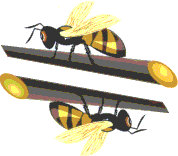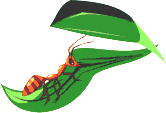Walking on the Ceiling
 Ants, bees, and their relatives do some amazing things. One of these things
is to walk across a ceiling upside down, but another is clinging to slippery
leaves--even ice-covered ones--as the wind rocks and shakes the leaf violently.
I recently saw a film clip showing these insects doing this in slow motion.
Not only is the process amazing, but the complex mechanical design is also
incredible.
Ants, bees, and their relatives do some amazing things. One of these things
is to walk across a ceiling upside down, but another is clinging to slippery
leaves--even ice-covered ones--as the wind rocks and shakes the leaf violently.
I recently saw a film clip showing these insects doing this in slow motion.
Not only is the process amazing, but the complex mechanical design is also
incredible.
These insects have suction pads on their feet. On both sides of the suction
pads are claws which can be retracted. The suction pads are inflated when
the claws are retracted, allowing the insect to cling to the surface. When
the insect deflates the pad, the foot detaches from the surface with the
claws extended. If the insect is on a rough surface when suction is not
required, the claws stay extended and the pads stay folded.
Dr. Bert Hšlldobler, the director of the team studying the locomotion
of these insects says, "This is a striking example of a peripheral structure
that features complex mechanical design, but works with relatively simple,
central control."
 The question we would raise is how such "complex mechanical design" comes
about. I frequently hear entomologists describe these patterns in insects
as blueprints that allow the creatures to function in unique ways. They are
referring, of course, to genetic blueprints which allow all members of the
species to have the same specialized equipment. We would suggest that the
blueprint is carefully drawn and designed by a Designer that created life
forms to fit unique environments in complex and marvelous ways. "Go to the
ant, you sluggard; consider its way and be wise" (Proverbs 6:6).
The question we would raise is how such "complex mechanical design" comes
about. I frequently hear entomologists describe these patterns in insects
as blueprints that allow the creatures to function in unique ways. They are
referring, of course, to genetic blueprints which allow all members of the
species to have the same specialized equipment. We would suggest that the
blueprint is carefully drawn and designed by a Designer that created life
forms to fit unique environments in complex and marvelous ways. "Go to the
ant, you sluggard; consider its way and be wise" (Proverbs 6:6).
--Reference: National Wildlife, December/January
2002, page 10.
Back to Contents Does God Exist?, NovDec02.
 The question we would raise is how such "complex mechanical design" comes
about. I frequently hear entomologists describe these patterns in insects
as blueprints that allow the creatures to function in unique ways. They are
referring, of course, to genetic blueprints which allow all members of the
species to have the same specialized equipment. We would suggest that the
blueprint is carefully drawn and designed by a Designer that created life
forms to fit unique environments in complex and marvelous ways. "Go to the
ant, you sluggard; consider its way and be wise" (Proverbs 6:6).
The question we would raise is how such "complex mechanical design" comes
about. I frequently hear entomologists describe these patterns in insects
as blueprints that allow the creatures to function in unique ways. They are
referring, of course, to genetic blueprints which allow all members of the
species to have the same specialized equipment. We would suggest that the
blueprint is carefully drawn and designed by a Designer that created life
forms to fit unique environments in complex and marvelous ways. "Go to the
ant, you sluggard; consider its way and be wise" (Proverbs 6:6). Ants, bees, and their relatives do some amazing things. One of these things
is to walk across a ceiling upside down, but another is clinging to slippery
leaves--even ice-covered ones--as the wind rocks and shakes the leaf violently.
I recently saw a film clip showing these insects doing this in slow motion.
Not only is the process amazing, but the complex mechanical design is also
incredible.
Ants, bees, and their relatives do some amazing things. One of these things
is to walk across a ceiling upside down, but another is clinging to slippery
leaves--even ice-covered ones--as the wind rocks and shakes the leaf violently.
I recently saw a film clip showing these insects doing this in slow motion.
Not only is the process amazing, but the complex mechanical design is also
incredible.